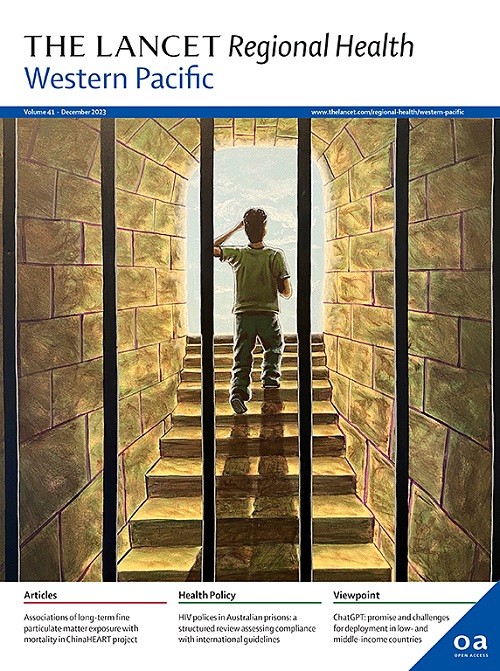Trends in mortality for gastric cancer from 2011 to 2020 with prediction to 2030: a Bayesian age-period-cohort analysis
IF 7.6
1区 医学
Q1 HEALTH CARE SCIENCES & SERVICES
引用次数: 0
Abstract
Background
Gastric cancer was the 3rd most common cause of cancer deaths, accounting for 11.3% of all cancer deaths in China in 2018. The study aims to analyze trends in gastric cancer mortality in China from 2011 to 2020, and predict the future burden of gastric cancer from 2021 to 2030.
Methods
Relevant data on gastric cancer were obtained from the National Mortality Surveillance System, which is available from the Chinese Center for Disease Control and Prevention. All deaths with underlying cause of death as gastric cancer (International Classification of Diseases-10 code: C16) were included. We analyzed the numbers and age-standardized mortality rates (ASMR) for gastric cancer by sex and urbanicity in China during 2011-2020. A Bayesian age-period-cohort (BAPC) prediction model was used to predict gastric cancer mortality by sex and urbanicity in China from 2021 to 2030. The gastric cancer death data from 2011 to 2020 were categorized into five-year age groups, from 0-4 to 80+. Population data for 2011-2020 were obtained from the National Bureau of Statistics. Projected population data for 2021-2030 were based on estimates derived from 2011-2020 population. The standard population for calculating ASMR was derived from the China Census in 2020.
Findings
In 2020, the ASMR for gastric cancer was 22.24/100,000, accounting for 291.20 thousand deaths in China, including 199.66 thousand males and 91.53 thousand females. The ASMR in males (32.57/100,000) was higher than that in females (13.09/100,000). From 2011 to 2020, the number of gastric cancer deaths in China showed a gradual downward trend, with a notable decline in the ASMR. From 2021 to 2030, the ASMR for gastric cancer in China is expected to continue declining. In 2030, It is anticipated that the ASMR of gastric cancer in China will be 11.68/100,000, resulting in an estimated 218.93 thousand deaths. The ASMR for males is projected to decrease to 17.78/100,000, representing a 45.4% reduction from 2020. For females, the ASMR will decrease to 6.81/100,000 corresponding to a significant reduction of 48.0% from the 2020. In 2030, the projected ASMR for gastric cancer is 11.67/100,000 in urban areas and 12.04/100,000 in rural areas, accounting for 111.90 thousand and 125.92 thousand deaths, respectively. Compared to 2020, the ASMR for gastric cancer in 2030 shows a 38.7% and 50.9% reduction in urban and rural areas, respectively.
Interpretation
From 2011 to 2020, both the number of deaths and the ASMR of gastric cancer in China gradually declined. The number of gastric cancer deaths in China is projected to continue declining through 2030. The findings indicate that the preventive and control measures for gastric cancer are effective and may provide useful reference for development of preventive and control strategies for other major cancers in China.
2011 - 2020年胃癌死亡率趋势及2030年预测:贝叶斯年龄-时期-队列分析
背景:胃癌是癌症死亡的第三大常见原因,占2018年中国所有癌症死亡人数的11.3%。本研究旨在分析2011 - 2020年中国胃癌死亡率趋势,预测2021 - 2030年未来胃癌负担。方法胃癌相关数据来源于中国疾病预防控制中心国家死亡率监测系统。所有潜在死亡原因为胃癌的死亡(国际疾病分类-10代码:C16)都包括在内。我们分析了2011-2020年中国按性别和城市化程度划分的胃癌人数和年龄标准化死亡率(ASMR)。采用贝叶斯年龄-时期-队列(BAPC)预测模型预测2021 - 2030年中国按性别和城市化程度划分的胃癌死亡率。2011年至2020年胃癌死亡数据分为5个年龄组,从0-4岁到80岁以上。2011-2020年人口数据来源于国家统计局。2021-2030年的预测人口数据基于2011-2020年人口的估计。计算ASMR的标准人口来源于2020年中国人口普查。发现2020年,中国胃癌的ASMR为22.24/10万,死亡人数为29.12万,其中男性199.66万,女性91.53万。男性ASMR(32.57/10万)高于女性(13.09/10万)。从2011年到2020年,中国胃癌死亡人数呈逐渐下降趋势,ASMR明显下降。从2021年到2030年,中国胃癌ASMR预计将继续下降。预计到2030年,中国胃癌的ASMR将为11.68/10万,预计将导致21893万人死亡。男性的ASMR预计将降至17.78/10万,比2020年下降45.4%。女性的ASMR将降至6.81/10万,比2020年大幅下降48.0%。到2030年,预计城市地区胃癌的ASMR为11.67/10万,农村地区为12.04/10万,死亡人数分别为11.19万人和12.592万人。与2020年相比,2030年城市和农村胃癌ASMR分别下降38.7%和50.9%。从2011年到2020年,中国胃癌的死亡人数和ASMR都在逐渐下降。预计到2030年,中国胃癌死亡人数将继续下降。研究结果表明,胃癌的防治措施是有效的,可为中国其他主要肿瘤的防治策略的制定提供有益的参考。
本文章由计算机程序翻译,如有差异,请以英文原文为准。
求助全文
约1分钟内获得全文
求助全文
来源期刊

The Lancet Regional Health: Western Pacific
Medicine-Pediatrics, Perinatology and Child Health
CiteScore
8.80
自引率
2.80%
发文量
305
审稿时长
11 weeks
期刊介绍:
The Lancet Regional Health – Western Pacific, a gold open access journal, is an integral part of The Lancet's global initiative advocating for healthcare quality and access worldwide. It aims to advance clinical practice and health policy in the Western Pacific region, contributing to enhanced health outcomes. The journal publishes high-quality original research shedding light on clinical practice and health policy in the region. It also includes reviews, commentaries, and opinion pieces covering diverse regional health topics, such as infectious diseases, non-communicable diseases, child and adolescent health, maternal and reproductive health, aging health, mental health, the health workforce and systems, and health policy.
 求助内容:
求助内容: 应助结果提醒方式:
应助结果提醒方式:


